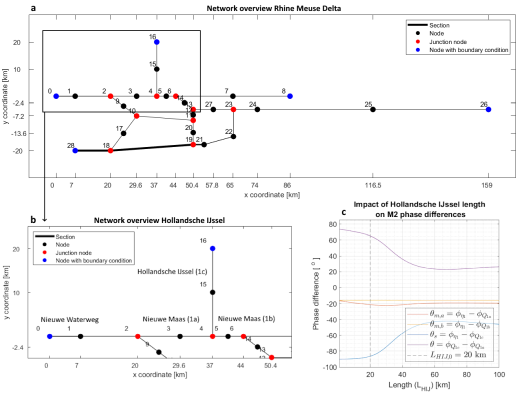J. de Wilde1*, W.M. Kranenburg1,2 , Y. Huismans1,2, J.D. Pietrzak1, G.G. Hendrickx1
1 Delft University of Technology; 2 Deltares
* Corresponding author: j.dewilde-1@student.tudelft.nl
Introduction
The Hollandsche IJssel plays an important role in the freshwater provision of the province Zuid-Holland. Consequently, for Rijkswaterstaat it is key that salt intrusion is minimal in the Hollandsche IJssel. Recent studies noted that currently, salt intrusion in the Hollandsche IJssel is limited due to a phase difference between tidal velocities in the main channel, the Nieuwe Maas, and the side channel, the Hollandsche IJssel (Kuijper, 2015, 2016; Laan et al., 2021). Earlier, Okubo (1973) and MacVean and Stacey (2011) investigated the impact of phase differences between branches and found it can lead to increased dispersion in the main channel, a process known as tidal trapping. At the same time, this phase difference can prevent the saltiest water from entering the side channel, as was found at the Hollandsche IJssel. Because of this role, it is relevant to find out how this phase difference may be influenced by sea level rise, more extreme river discharges and particularly how it depends on the geometry of the main and the side channels. Especially the latter could help Rijkswaterstaat to minimize salt intrusion at locations relevant to freshwater intake, such as the Hollandsche IJssel.
Objective and Methods
The main objective of this thesis is to investigate how the geometry of the side and main channel influences the tidal phase difference between these two channels, and how this may impact the salt dispersion in the side channel. For this, we developed an analytical model describing harmonic wave propagation in multi-branch systems and used this next to results from a 3D numerical model for the Rhine Meuse Delta (RMM3D). We first systematically investigated the influence of changes in geometry and forcing for a network containing a single junction. Next, we determined the phase differences for the junctions with the Hollandsche IJssel and the Lek in the Rhine Meuse Delta based on the RMM 3D model. Subsequently, we model the Rhine Meuse Delta with the analytical model and use this to investigate possibilities to optimize the phase differences at these junctions to minimize salt intrusion.
Results
This research indicates that the geometric variables with the largest impact are the length and depth of the side channel. The length is important as it directly governs the reflection and potential resonance in the side channel. The depth is one of the main variables impacting friction, which determines if standing waves can form. The analytical model of the Rhine Meuse Delta showed it can adequately represent the current phase differences at the Hollandsche IJssel and the Lek. In addition, it can predict the sign and order of magnitude for changes in the geometry. The results show there are only limited possibilities to optimize the phase difference at the Hollandsche IJssel to further reduce salt intrusion. The current geometry of the Lek allows more significant changes to optimize the phase difference at this junction. For example, to increase the phase difference with 5° at the Hollandsche IJssel the length of the branch would need to be reduced by 10 km, compared to only 4 km at the Lek. A first estimate shows an increased phase difference can further limit salt intrusion, based on the salinity in the Nieuwe Maas.

Figure 1: a) Overview of the Rhine Meuse Delta in the analytical model, and b) a more detailed overview of the junction with the Hollandsche IJssel. c) Phase differences between water level and discharge for each channel section connected to the junction with the Hollandsche IJssel (node 4 in panel a and b) as a function of the Hollandsche IJssel length. The phase difference influencing salt intrusion is given in purple as the phase difference between the discharge in the Hollandsche IJssel and the discharge in the Nieuwe Maas (1a); in orange the phase difference between water level and discharge of the Nieuwe Maas (1a); in yellow the phase difference between water level and discharge of the Nieuwe Maas (1b); in blue the phase difference between water level and discharge for the Hollandsche IJssel; and the dashed line shows the current length of the Hollandsche IJssel. The result shows that shortening the Hollandsche IJssel would increase the phase difference between the discharges. However, the effect is limited as the current length is in a region with a small slope coefficient.
References
Kuijper C., (2015), Analyse debiet- en zoutmetingen hollandsche ijssel. Report, Deltares.
Kuijper C., (2016), Analyse van de zoutmetingen in november 2015 langs de hollandsche ijssel. Report, Deltares.
Laan S., Chavarrias V., Huismans Y., and Van der Wijk R., (2021), Verzilting hollandsche ijssel en lek. Report, Deltares.
MacVean L. J. and Stacey M. T., (2011), Estuarine dispersion from tidal trapping: A new analytical framework. Estuaries and Coasts, 34(1):45–59.
Okubo A., (1973), Effect of shoreline irregularities on streamwise dispersion in estuaries and other embayments. Netherlands Journal of Sea Research, 6(1):213–224.


